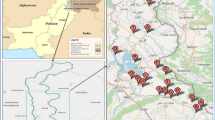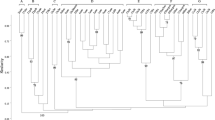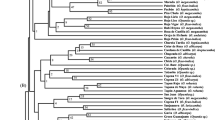Abstract
Genetic relationships were estimated among 24 accessions belonging to 11 species of Capsicum, using 2,760 RAPD markers based on touch-down polymerase chain reactions (Td-RAPD-PCR). These markers were implemented in analyses of principal coordinates, unweighted pair group mean average, and 2,000 bootstrap replications. The accessions were divided into four groups, corresponding to previously described Capsicum complexes: C. annuum complex (CA), C. baccatum complex (CB), C. pubescens complex (CP), and C. chacoense accessions (CA/B). Their overall mean genetic similarity index was 0.487 ± 0.082, ranging from 0.88 to 0.32, based on Jaccard’s coefficient. The highest genetic variation was observed among the accessions in CP; the accessions in CB had a low level of variation as judged from the standard deviations of the genetic similarity indices. Based on the Td-RAPD-PCR markers, the 24 accessions were divided into four major groups, three of which corresponded to the three distinct Capsicum complexes. Accessions of C. chacoense were found to be equally related to complexes CA, CB, and CP.



Similar content being viewed by others
References
Adetula OA (2006) Genetic diversity of Capsicum using random amplified polymorphic DNAs. Afr J Biotechnol 5:120–122
Cerny TA, Caetano-Anolles G, Trigiano RN, Starman TW (1996) Molecular phylogeny and DNA amplification fingerprinting of Petunia taxa. Theor Appl Genet 92:1009–1016
Choong CY (1998) DNA polymorphisms in the study of relationships and evolution in Capsicum. PhD thesis, University of Reading, UK
Ellsworth DL, Rittenhouse KD, Honeycutt RL (1993) Artifactual variation in randomly amplified polymorphic DNA banding patterns. Biotechniques 14:214–216
Eshbaugh WH (1982) Variation and evolution in Capsicum eximium Hunz. Baileya 21:193–198
Eshbaugh WH (1993) Peppers: history and exploitation of a serendipitous new crop discovery. In: Janick J, Simon JE (eds) New crops. Wiley, New York, pp 132–139
Guzman FA, Ayala H, Azurdia C, Duque MC, de Vicen MC (2005) AFLP assessment of genetic diversity of Capsicum genetic resources in Guatemala: Home gardens as an option for conservation. Crop Sci 45:363–370
Heiser CB, Smith PG (1953) The cultivated Capsicum peppers. Econ Bot 7:214–227
Hunziker AT (1950) Estudios sobre Solanaceae. I. Sinopsis de las especies silvestres de Capsicum de Argentina y Paraguay. Darwiniana 9:225–247
Hunziker AT (1956) Synopsis of the genus Capsicum. VIII Congrès International de Botanique, Paris, 1954. Compte Rendu des Séances Rapports et Communications 4:73–74
Hunziker AT (1998) Estudios sobre Solanaceae. XLVI. Los ajíes silvestres de Argentina (Capsicum). Darwiniana 36:201–203
Ince AG, Karaca M, Onus AN (2009) Development and utilization of diagnostic DAMD-PCR markers for Capsicum accessions. Genet Resour Crop Evol 56:211–221
Jain AS, Bhatia SS, Banga-Prakash S, Lakshmikuran M (1994) Potential use of random amplified polymorphic DNA (RAPD) technique to study the genetic diversity in Indian mustard (Brassica juncea) and its relationships to heterosis. Theor Appl Genet 88:116–122
Jarret RL, Dang P (2004) Revisiting the waxy locus and the Capsicum annuum L. complex. Georgia J Sci 62:117–133
Karaca M, Ince AG (2008) Minisatellites as DNA markers to classify bermudagrasses (Cynodon spp.): confirmation of minisatellite in amplified products. J Genet 87:83–86
Karaca M, Saha S, Zipf A, Jenkins JN, Lang DJ (2002) Genetic diversity among forage bermudagrass (Cynodon spp.): evidence from chloroplast and nuclear DNA fingerprinting. Crop Sci 42:2118–2127
Karaca M, Ince AG, Elmasulu SY, Onus AN, Turgut K (2005) Coisolation of genomic and organelle DNAs from 15 genera and 31 species of plants. Anal Biochem 343:353–355
Lefebvre V, Goffinet B, Chauvet JC, Caromel B, Signoret P, Brand R, Palloix A (2001) Evaluation of genetic distances between pepper inbred lines for cultivar protection purposes: comparison of AFLP, RAPD and phenotypic data. Theor Appl Genet 102:741–750
Manly BFJ (1994) Multivariate statistical methods: a primer. Chapman & Hall, London
McLeod MJ, Guttman SI, Eshbaugh WH, Rayle RE (1983) An electrophoretic study of the evolution in Capsicum (Solanaceae). Evolution 37:562–574
Moscone EA, Lambrou M, Hunziker AT, Ehrendorfer F (1993) Giemsa C-canded karyotypes in Capsicum (Solanaceae). Plant Syst Evol 186:213–229
Moscone EA, Loidl J, Ehrendorfer F, Hunziker AT (1995) Analysis of active nucleolus organizing regions in Capsicum (Solanaceae) by silver staining. Am J Bot 82:276–287
Moscone EA, Lambrou M, Ehrendorfer F (1996) Fluorescent chromosome banding in the cultivated species of Capsicum (Solanaceae). Plant Syst Evol 202:37–63
Moscone EA, Baranyi M, Ebert I, Greilhuber J, Ehrendorfer F, Hunziker AT (2003) Analysis of nuclear DNA content in Capsicum (Solanaceae) by flow cytometry and Feulgen densitometry. Ann Bot 92:21–29
Onus AN, Pickersgill B (2004) Unilateral incompatibility in Capsicum (Solanaceae): occurrence and taxonomic distribution. Ann Bot 94:289–295
Pang MX, Percy RG, Hughs E, Zhang JF (2009) Promoter anchored amplified polymorphism based on random amplified polymorphic DNA (PAAP-RAPD) in cotton. Euphytica 167:281–291
Pickersgill B (1988) The genus Capsicum: a multidisciplinary approach to the taxonomy of cultivated and wild plants. Biologisches Zentralblatt 107:381–389
Pickersgill B (1991) Cytogenetics and evolution of Capsicum L. In: Tsuchiya T, Gupta PK (eds) Chromosome engineering in plants: genetics, breeding, evolution, part B. Elsevier, Amsterdam, pp 139–160
Pickersgill B, Heiser CB, McNeill J (1979) Numerical taxonomic studies on variation and domestication in some species of Capsicum. In: Hawkes JG, Lester RN, Skelding AD, eds. The biology and taxonomy of the Solanaceae. Linnean Society Symposium 7. London: Academic Press, pp 678–700
Prince JP, Loaiza-Figueroa F, Tanksley SD (1992) Restriction fragment length polymorphism and genetic distance among Mexican accessions of Capsicum. Genome 35:726–732
Rahman SMZ, Khan MR, Shahidul I, Samsul A (2009) Genetic variation of wild and hatchery populations of the catla Indian major carp (Catla catla Hamilton 1822: Cypriniformes, Cyprinidae) revealed by RAPD markers. Genet Mol Biol 32:197–201
Rodriguez JM, Berke T, Engle L, Nienhuis J (1999) Variation among and within Capsicum species revealed by RAPD markers. Theor Appl Genet 99:147–156
Ryzhova NN, Kochieva EZ (2004) Analysis of microsatellite loci of the chloroplast genome in the genus Capsicum (pepper). Russ J Genet 40:892–896
Swofford DL (2002) PAUP 4: Phlyogenetic analysis using parsimony (and other methods), version 4. Sinauer Associates, Sunderland, MA
Tong N, Bosland PW (1999) Capsicum tovarii, a new member of the Capsicum baccatum complex. Euphytica 109:71–77
Tong N, Bosland PW (2003) Observations on interspecific compatibility and meiotic chromosome behavior of Capsicum buforum and C. lanceolatum. Genet Resour Crop Evol 50:193–199
Walsh BM, Hoot SB (2001) Phylogenetic relationships of Capsicum (Solanaceae) using DNA sequences from two non-coding regions: the chloroplast atpB-rbcl spacer region and nuclear waxy introns. Int J Plant Sci 162:1409–1418
Williams CE, St. Clair DA (1993) Phylogenetic relationships and levels of variability detected by restriction fragment length polymorphism and random amplified polymorphic DNA analysis of cultivated and wild accessions of Lycopersicon esculentum. Genome 36:619–630
Acknowledgments
This work was supported in part by the Scientific and Technological Research Council and the Scientific Research Projects Coordination Unit of Akdeniz University.
Author information
Authors and Affiliations
Corresponding author
Rights and permissions
About this article
Cite this article
Ince, A.G., Karaca, M. & Onus, A.N. Genetic Relationships Within and Between Capsicum Species. Biochem Genet 48, 83–95 (2010). https://doi.org/10.1007/s10528-009-9297-4
Received:
Accepted:
Published:
Issue Date:
DOI: https://doi.org/10.1007/s10528-009-9297-4




